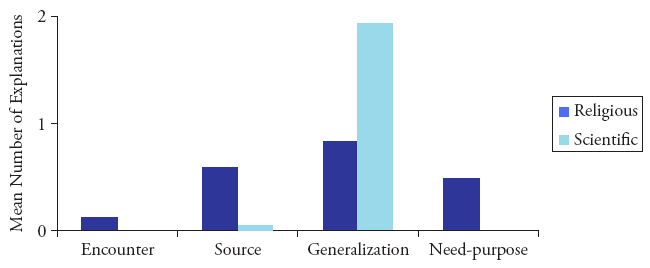Paul Harris, a psychologist at Harvard University, is interested in how children learn to differentiate between different kinds of knowledge. In his latest study, he’s teamed up with two Spanish psychologists to unpick the beliefs of young, Catholic children.
These 10-12 year olds have a pretty firm conviction in both God and the soul. They also believe (slightly more strongly, in fact) in invisible scientific entities, like oxygen and germs. What the team wanted to know was whether they believed in these things for the same reasons.
So they asked them how they know these entities exist. The replies were revealing.
The reasons the children gave were broken down into 4 categories:
- They had encountered the entity
- There was a written source or other authority that asserted the entity existed
- There was some feature of the entity that explained its existence in generalized terms (e.g. “Souls exist because everyone has their own way of being”, or “Germs are on the dirty things”)
- The existence of the entity is required because it fulfils some need or purpose (e.g. “God exists because he tells us the way).
The figure shows how often children gave each of these kinds of answers to justify the existence of religious and scientific entities.
Several different reasons were given for their belief in religious entities. For scientific entities, however, their reasoning was almost entirely based on the generalized properties or nature of the entity.
In fact, it’s even more interesting than that. Because the researchers also broke these ‘properties’ arguments down further, into whether or not they were causal explanations – “germs cause disease”, or “God has created all of us”.
For religious entities, only 17% of the already relatively few explanations under this category were causal. For scientific entities, it was very nearly 100%.
In other words, these young Spanish kids almost exclusively rationalise their belief in scientific entities in causal terms. There religious beliefs, on the other hand, were justified in a variety of ways that were almost never causal.
![]() Guerrero, S., Enesco, I., & Harris, P. (2010). Oxygen and the Soul: Children’s Conception of Invisible Entities Journal of Cognition and Culture, 10 (1), 123-151 DOI: 10.1163/156853710X497202
Guerrero, S., Enesco, I., & Harris, P. (2010). Oxygen and the Soul: Children’s Conception of Invisible Entities Journal of Cognition and Culture, 10 (1), 123-151 DOI: 10.1163/156853710X497202
 This article by Tom Rees was first published on Epiphenom. It is licensed under Creative Commons.
This article by Tom Rees was first published on Epiphenom. It is licensed under Creative Commons.














